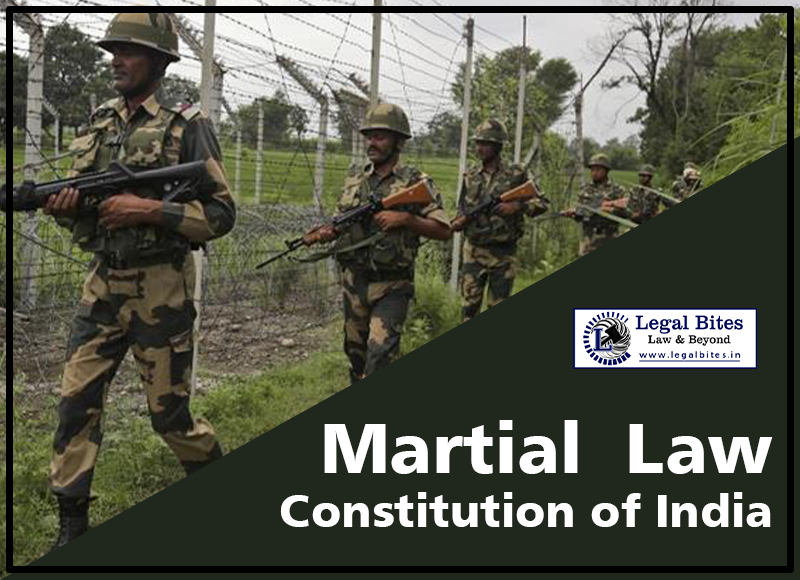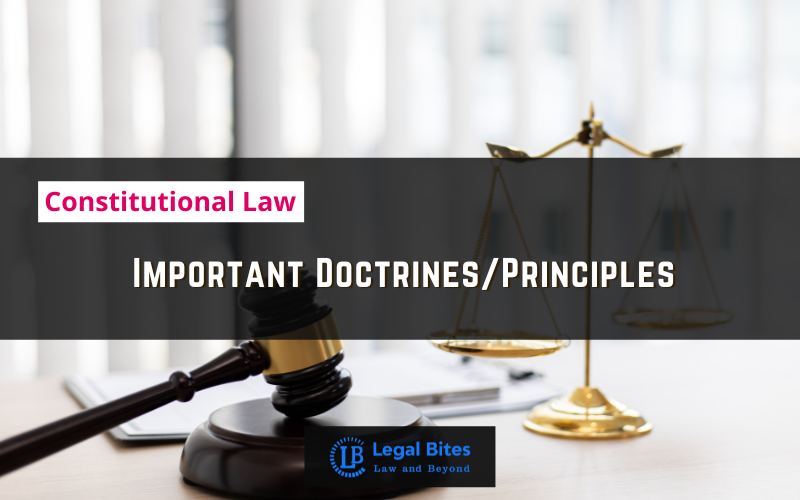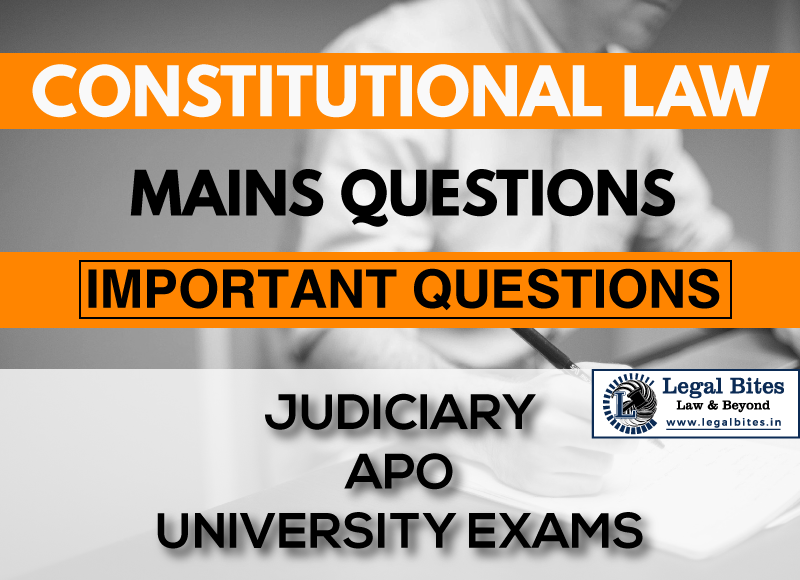Martial Law in the Constitution of India
Martial law is the law administered by military forces that are invoked by a government in an emergency when the civilian law enforcement agencies are unable to maintain public order and safety. Basically, when martial law is enforced then all the other, ordinary and general laws, become null and void. These may include even the revocation of fundamental… Read More »
;
Martial law is the law administered by military forces that are invoked by a government in an emergency when the civilian law enforcement agencies are unable to maintain public order and safety. Basically, when martial law is enforced then all the other, ordinary and general laws, become null and void. These may include even the revocation of fundamental rights also. At the time when martial law is enforced, the military has supreme powers to make a decision in order to restore peace in...
Martial law is the law administered by military forces that are invoked by a government in an emergency when the civilian law enforcement agencies are unable to maintain public order and safety. Basically, when martial law is enforced then all the other, ordinary and general laws, become null and void. These may include even the revocation of fundamental rights also.
At the time when martial law is enforced, the military has supreme powers to make a decision in order to restore peace in the society. Martial law is significantly different in many countries and the provisions under the Constitution of a country is also very distinctive towards martial law.
I. Introduction
Martial law is justified when civilian authority has ceased to function, is completely absent, or has become ineffective. Further, martial law suspends all existing laws, as well as civil authority and the ordinary administration of justice. As mentioned earlier, the military has supreme control, it can enforce any laws to restore the normalcy.
These heavy steps come with the sacrifice of general laws and human rights as well, in some situations like curfew, there is an order for the shoot at sight[1]. So, many innocent civilians die just because they were spotted on roads. The enforcement of martial law has been quite a controversial topic as there comes the question of violation of human rights. But, it is to be noted that martial rights are for the safety of the public only and hence for the sake of safety, their rights may be scrapped away for a temporary basis.
In the United States, martial law may be declared by proclamation of the President or a State governor, but such a formal proclamation is not necessary. Although the U.S. Constitution makes no specific provision for the imposition of martial law, nearly every state has a constitutional provision authorizing the government to impose martial law. The power of martial law, once held to be nearly absolute, has limitations
In India, the martial law is described under Article 34 of the constitution. This article imposes a restriction on fundamental rights while martial law is enforced in an area within the territory of India. One thing to be noted is the parliament or the government do continue its work when martial law is enforced. This is in almost every country. So, the martial law empowers the parliament to indemnify any government servant or any others for any act done with respect to restoration of order where martial law was in force.
II. Martial Law and National Emergency
Martial law is not described in the Constitution of India. Though the article 34 gives provisions for such situations it does not specifically state about the martial law. Martial law or such provisions are said to be imposed during extraordinary circumstances like war, insurrection, invasion, rebellion or any sort of violent condition. Moreover, it is imposed at the time of a national emergency. Again, it is to be noted that in most situations, the martial law and national emergency are imposed together. They both have their own odds. Some odds may run hand in hand while others may work independently[2].
Abnormal powers including imposing restrictions and regulations on the rights of the civilians, can punish the civilians and even condemn them to death. The Supreme Court held that the declaration of martial law does not ipso facto result in the suspension of the writ of habeas corpus.
Now let’s see some differences between martial law and national emergency[3]:
- Ordinary laws are suspended during martial law, but courts and government do continue to work when a national emergency is imposed.
- Martial law is said to affect the fundamental rights and even some human rights as well, but national emergency in broader scope will affect the working of centre-state relationship, legislative powers, fundamental rights and revenue distribution as well.
- Martial law at times can be imposed in some areas of the country, but a national emergency is imposed on the whole of the nation. At times of war, invasion, riot, strike, revolt the situation can be called worse when a national emergency is imposed and martial law is enforced upon the whole of the country.
- Martial law imposed to restore the breakdown of law and order due to any reason, while National Emergency can be imposed only on three grounds (Article 352) i.e. War, External aggregation or armed rebellion.
III. Martial Law according to US constitution
The federal government of the United States is bound all the times by its Constitution. Even when there is the enforcement of martial law, the government cannot suspend or violate constitutional rights. Additionally, the martial law declarations and its enforcement are completely subject to the US system of judicial review.
For example, if the federal government places a state or territory under martial law, individuals detained by the military can ask a federal court to order their release by petitioning for the writ of habeas corpus. Subsequently, if a court considers the petition, it can decide whether the declaration of martial law was constitutional in the first place[4].
The Supreme court of the United States have also held the individual states can also declare martial law in their provinces and such a declaration will only be valid if it is according to the US constitution or the laws of the respective state. However, even under martial law, the state officials and dignitaries are bound by the US constitution and the federal law. Moreover, an individual can challenge the declaration of martial law, by a state, by seeking injunctive relief in federal court and if they are detained, they can file a writ petition for habeas corpus.
Now, let’s see what the US Congress said about the martial law. The President cannot declare martial law as there are no such federal statues for it. However, while Congress has passed several laws related to a domestic military takeover, these laws do not simply create restrictions. They are just in place to restore the normalcy in a peaceful manner. Congress has also given the president considerable authority to use troops domestically in ways short of martial law.
The Insurrection Act, and potentially Title 32 as well, allow the president to deploy the military to assist civilian authorities with law enforcement activities virtually whenever and wherever the president chooses. In some scenarios, deployment of troops under these statutes might appear similar to a declaration of martial law. These ambiguities and the breadth of the president’s statutory authority point to the need for Congress to pass legislation that better defines the scope and limits of presidential powers — both for martial law and for other domestic uses of the military.
IV. Imposition of Martial law In India
Martial law has been imposed several times in India during its pre-independence period. Moreover, the martial laws where enforced rightly at the time when there was a fight for freedom. The first such martial law was imposed in 1817 in Cuttack, Odisha. This was a war for independence called the Paika Rebellion. It lasted for one complete year and was lifted in 1818. Several deaths were reported during this period. The life of people was at stake. But, again, since this was a fight for the freedom it was considered as a historic war.
After the above war, again the martial law was imposed in 1857, during Sepoy Mutiny, ought to be called the First War of Independence. It was much greater than the one in 1817. Accordingly, as time passed the revolt and fight for freedom continued and martial law was imposed many times. So, at the time of framing our constitution, the makers had kept in mind to make such laws which will control the martial law. And hence, Article 34 was inducted in our constitution. And, the good thing is martial law has never been imposed in India, post-independence till date.
V. Conclusion
Martial law can be seen as a law which tries to restore the normal law and order a place. But, if mishandled with then can be disastrous. Many people oppose the imposition of martial law questioning the violation of human and fundamental rights, but they forget the good faith of the martial law, which is the protection of human life.
The martial law should be under the constitution so as the military could not take any advantage of the supreme powers provided to them. The martial law should be also regulatory with checks and balances like the three organs of the government- legislative, executive, judiciary; none is completely independent. And for the public, they should follow martial law, whenever imposed, in such a manner that it shouldn’t harm them. After all, it was for the sake of general human life only.
References:
- D. Basu, Commentary on the Constitution of India, vol. 6, Ed. 8, 2011.
- P. Jain, Indian Constitutional Law, 8th ed. 2018
[1] K. Gautam, Martial Law in India, Sw. J. Int’l L. vol. 24, pp. 117.
[2] V.D. Sebastian, Martial Law and the Defence of Constitutional Order in India, Ker. Uni. L.R. vol. 12, pp. 172 – 195.
[3] M.P. Jain, Indian Constitutional Law, 8th ed. 2018, 1127.
[4] Mark Nucleus, From Martial Law to the War on Terror, New Cri. L. R. vol. 10(4), pp. 489-513.




